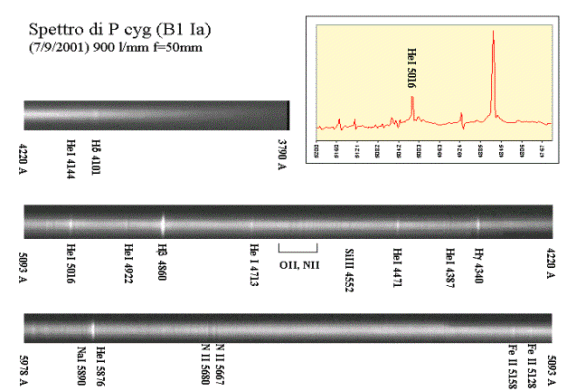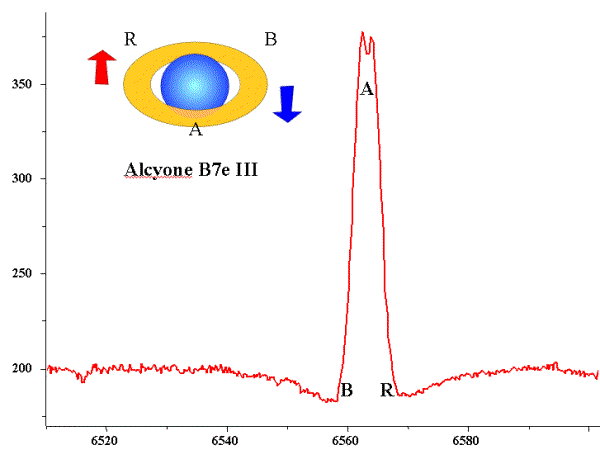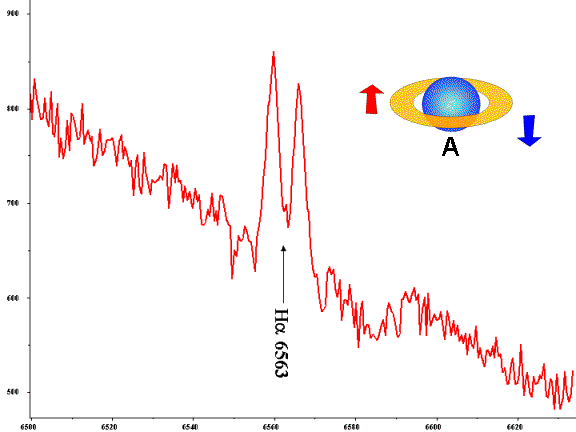NORMAL STARS SPECTRA
Spectral types:
O
- B
- A
- F
- G
- K
- M
Type B stars
Stars belonging to B type encompass a wide temperature range: From 10000 K of B9 to 30000 K
of B0. For this reason are often introduced decimal subclasses. As an example
b Scorpii Ŕ classificata B0.5).
Bright stars belonging to B type are numerous:
Among the main sequence dwarfs:
b Scorpii (B0.5 V),
h Ori (B1 V),
hUma (B3 V),
hAur (B3 V), Algol (B8 V), Regulus (B8 V)
Among the giants:
d Sco (B0 IV),
Spica (B1 III-IV),
g Orionis (B2 III),
g Peg (B2,5 IV),
Merope-h Tauri (B5 III),
b Tau (B8 III)
Among the supergiants:
e Orionis (B0 I),
k Cas (B1 Iae),
c Aur (B3 I),
h CMa (B5 I),
b Orionis (B8 Iae)

|
|
Picture 1: Spectrum of Bellatrix (g Ori, B2 III)
recorded with resolution better than 1 ┼. Click on the image for detailed spectrum and spectral lines identicication.
|
Compared to A type stars that show the maximum intensity of hydrogen Balmer lines, the B type stars
show the maximum strength of neutral Helium lines. Neutral Helium lines appears at B9
and reach maximum at B2. From B2 toward higher temperature they weakens again and leave the place to ionized Helium lines.
Giants are distinguished from the dwarfs because of the weakening and sharpening of H and He+ lines
and increase of ionized elements lines (Si III, Si IV, O II are used for classification in B0-B2 while C II
is used for B3 - B5).
Peculiar stars subclasses: P Cyg stars
Stars of class B sometimes show spectral evidences of strong stellar winds that disperse
huge amount of gases in the surrounding space.
The main example of this type of B stars is P Cyg that shows, superposed to the spectrum of a normal
B1 Ia star, emission lines due to shell of gas emitted from the star.
The higly energetic UV radiation from the star creates excited ionized and neutral atoms in the expanding gas.
Disexcitation of this gas produces the emission lines.
Emission lines are coupled to blue shifted absorbptions, due to the gas expanding from the star in the direction
of the observer.
Remembering that Dl/l =v/c ,
from the 2 ┼ Doppler shift between emission and absorbption line we can calculate a flow speed of
the gas around 100 Km/sec.

|
Picture 2: Spectrum of P Cygni registered with spectrograph equipped with 900 l/mm grating and
camera focal length = 50 mm at the Cassegrain focus of 60 cm reflector.
In the inset it is shown a spectral profile of the part of the spectrum that surrounds H beta line.
Many absorbption lines are blue shifted and coupled with emissions and originates from the expanding gas
flowing outward from the hot star.
|
Peculiar stars subclass: Be
stars
In addition to P Cyg type subclass, many other B stars show emission lines due to a disk of gas
that rotates (evenctually with expansion) around the star. The disk is produced by the high
surface rotation speed (up to 200 Km/sec) of the star.
The disk is not always stable and its variations cause fast changes in the emission line shape.
Emission lines are often doubled due to the opposite Doppler shift of the two sides of the
rotating disk. In between the two emission lines an absorption line can be seen due to
that part of the disk rotating in front of the star. This part of the disk has no radial speed component.
The shape of the line is related to the inclination of the emitting disk.
Central absorption increases when the disk plane has little inclination in respect to the line
of sight (as in the example of w Ori), while disks that are seen
face-on show only a little absorption (As in the example of Alcyone).

|
|
Picture 3: A small part of Be starh Tau
(Alcyone, the brightest member of Pleyades cluster),
centered around H a with 0,27 ┼/pixel dispersion and R=10'000.
The spectrum has been recorded on 14th dec 2004 with MX5 Xpress CCD with a 0.6 m F/15 Cassegrin telescope and 5 min exposure.
|

|
|
Picture 4: A small part of the spectrum of Be starw Ori,
centered around H a with 0,43 ┼/pixel dispersion.
The spectrum has been recorded on MX5 Xpress CCD with a 0.6 m F/20 Cassegrain telescope.
|
Goto other spectral types:
O
- B
- A
- F
- G
- K
- M
|




